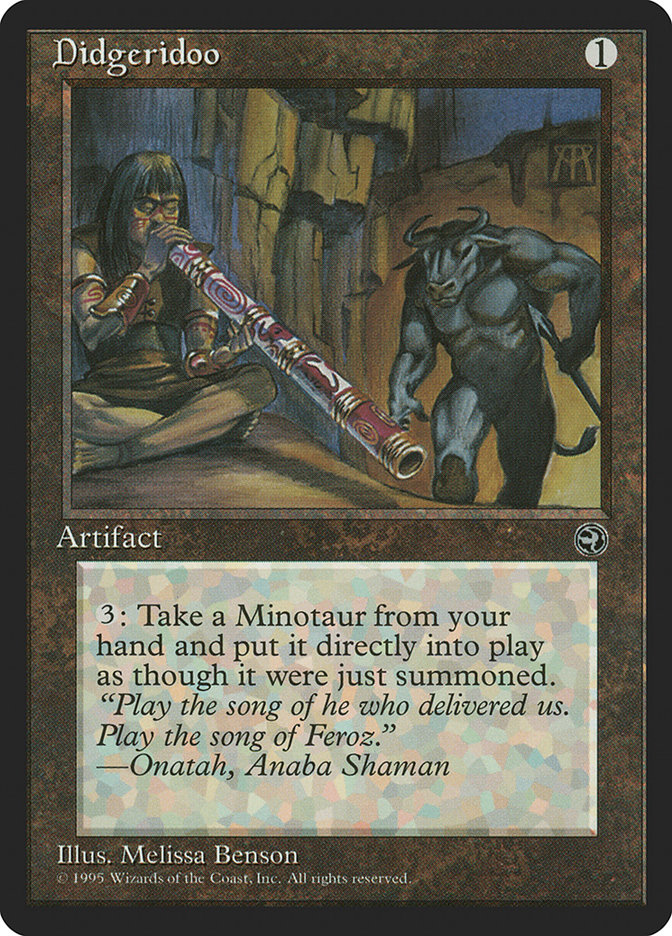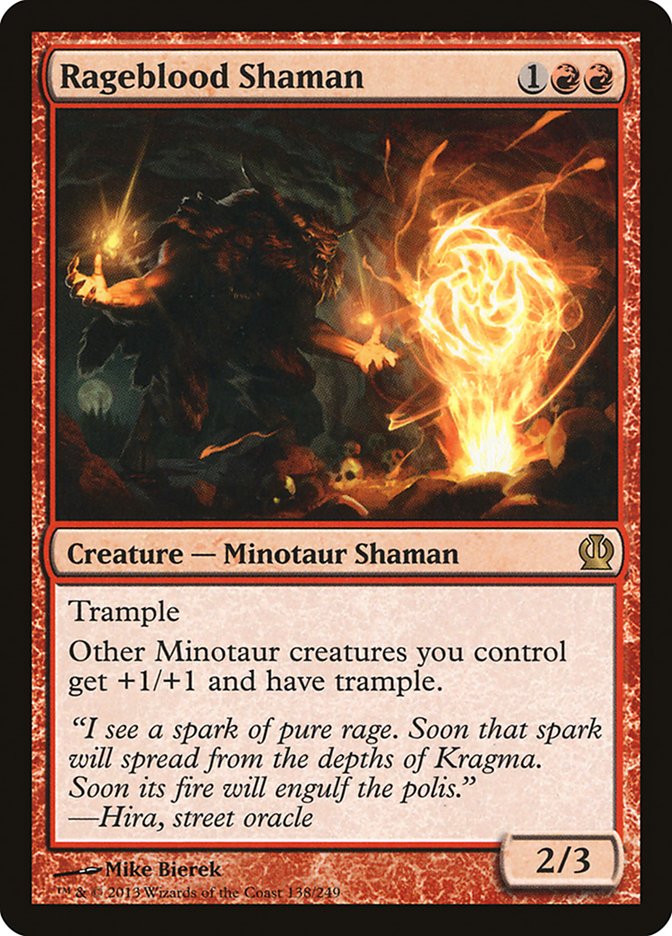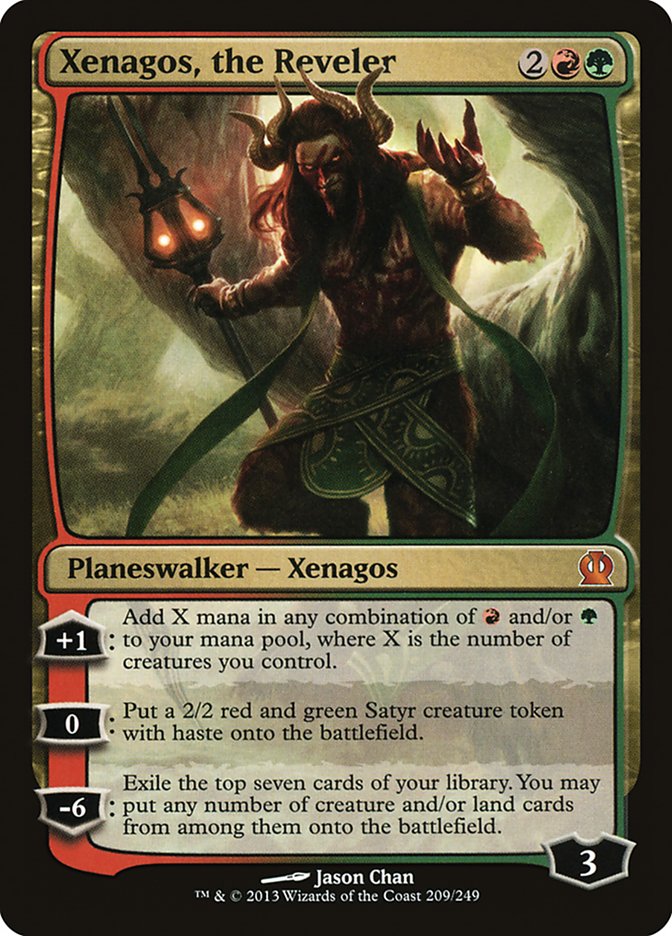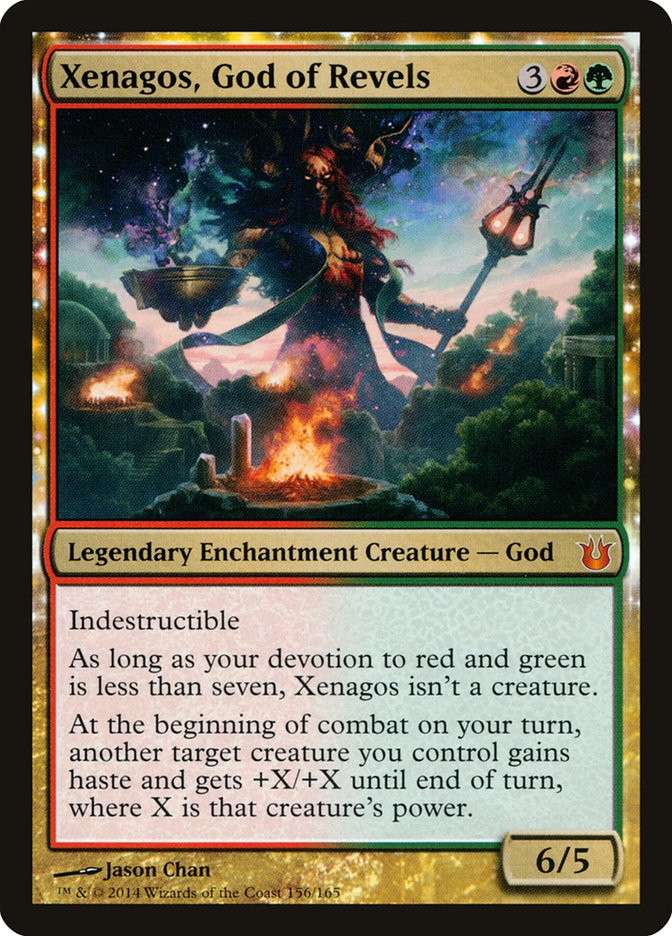Spoiler: At least one of these three is the big breakthrough that breaks up the B vs. U vs. U/W vs. occasional W/B metagame . . .
The Born of the Gods Prerelease is this weekend, which is particularly interesting in that we haven’t had a two-set Limited format since Innistrad + Dark Ascension. As for Constructed, Born of the Gods is in a little bit of an odd situation. The Constructed Pro Tour that immediately follows it is Modern, and any change to the banned list is probably going to be more impactful than the few cards from the set that might actually see play.
Standard, though?
Standard really needs a jolt in the arm, as the format has very squarely settled into an equilibrium. Mostly Mono-Black, mostly Mono-Blue, and U/W/x. Less than 30% of Grand Prix Vancouver’s day 2 metagame involved any green or red cards at all!
Tell you what. Today we’re going to look at some of the new red and green cards and take the gloves off. Thoughtseize, Thassa, and Sphinx’s Revelation? We’re going to need some pretty serious technology if we want to break up that little balance of power.
Alright, this little bad boy isn’t exactly legal, but the Minotaur tribe has been pushed for the first time since Homelands. Are Minotaurs the next Zombies?
That’s your big plan? Minotaur tribal?
Okay, Minotaurs, huh? Sure, let’s do this. First, the list:
Creatures (32)
- 4 Boros Reckoner
- 4 Rageblood Shaman
- 4 Kragma Warcaller
- 4 Fanatic of Mogis
- 4 Firedrinker Satyr
- 4 Deathbellow Raider
- 4 Ragemonger
- 4 Felhide Brawler
Lands (23)
Spells (5)
Sideboard

Born of the Gods gives us Felhide Brawler and Ragemonger, which is actually pretty helpful as far as tools for Minotaur decks go. The Brawler gives us a much-needed second two-drop, and Ragemonger gives us the possibility of some pretty respectable nut draws, not to mention making Kragma Warcaller a realistic possibility with only 23 lands.
No, Firedrinker Satyr is not a Minotaur, and yeah, obviously we really would have loved a one-drop Minotaur. But at least we gain Temple of Malice. Boros Reckoner is one of the few truly great Minotaurs, and trying to cast it without Temple of Malice was challenging to say the least. Even with it we still have a couple Godless Shrines to give us black on turn 2 without costing us Boros Reckoner on turn 3.
I’d love to be able to play four Mutavaults. Maybe we’re just supposed to be greedy and rock it, but we’re going to be absolutely devastated if we miss early pressure. I could see us going down even further, though we do have to ask ourselves if we’re really getting enough out of the Minotaur tribe.
Fanatic of Mogis gives us some serious reach despite being a basically mono-dude deck.
So that’s the good news. The bad news however is that two of the three top decks in Standard are Mono-Black (with a ton of spot removal and Pack Rat) and U/W/x (with Supreme Verdict, Detention Sphere, and more). We might be somewhat okay against Mono-Blue, but Thassa and Master of Waves are disasters for us, not to mention how much of a blowout Rapid Hybridization or Cyclonic Rift would be.
The challenging thing about the Minotaur tribe is that most of them are slightly below rate so you actually need at least one lord to not be “behind.” On top of this, most of them don’t actually do anything besides serve mediocre beats. There aren’t exactly a lot of utility Minotaurs, you know?
Filling our deck with lots of Minotaurs in order to capitalize on the twelve lords leaves us with very few spells. Mizzium Mortars is great under such circumstances, but we do have a lot of gaping holes—Master of Waves, Desecration Demon, and so on. At least we can trample over the Elspeth tokens I guess.
Does Ragemonger have what it takes to show up in tournament decks?
Verdict: Niche Staple For An Uncommon Deck
It looks to be the cornerstone of a fringe Constructed deck that is probably tier 2 at best. Probably not bad for being an FNM hero, but unlikely to win a GP (unless Alexander Hayne plays it).
Okay, so maybe Ragemonger isn’t the key to breaking up black, blue, and white’s stranglehold on the format. At least red gets Fated Conflagration, Flame-Wreathed Phoenix, and Searing Blood. It may not be as fancy as Ragemonger shenanigans, but here’s a more traditional red deck that gets some nice new tools:
Creatures (22)
- 4 Chandra's Phoenix
- 4 Ash Zealot
- 4 Rakdos Cackler
- 4 Young Pyromancer
- 1 Stormbreath Dragon
- 4 Firedrinker Satyr
- 1 Flame-Wreathed Phoenix
Planeswalkers (1)
Lands (23)
Spells (14)

Searing Blood is a tricky one to evaluate. On one hand, when it works the amount of power you get for so little mana is above and beyond any of the rest of the burn cards. Searing Blaze was an absolutely incredible card, and while Searing Blood isn’t quite at that level (doesn’t kill a Nightveil Specter, actually needs to kill the creature to dome the player), it is some much-needed power.
The catch of course is that you actually have to make it work. Yeah, the card is pretty bonkers against one- and two-toughness creatures like Mutavault and Tidebinder Mage, but it is really easy for Searing Bloods to get stranded in your hand against control.
Even when playing against black, you aren’t always going to just “get” their Pack Rat with it. Sometimes it is going to have to pair up with a Shock to kill a Nightveil Specter or a Gray Merchant of Asphodel. Trying to kill a Desecration Demon is an even taller order, generally requiring three burn spells (or two and a block). At least Searing Blood pays you on the back side.
There are enough people playing Sphinx’s Revelation and Gray Merchant that I actually wouldn’t mind trimming the loose burn spells (Magma Jet and Flames of the Firebrand) for a couple of maindeck Skullcracks. That really sets us up to have problems against fat creature decks, but honestly Polukranos, World Eater is going to be a nightmare for us anyway. Who are we kidding? Maybe we just focus on the battles we can actually win.
Searing Blood is the red card I’m most excited about for red aggro, but Flame-Wreathed Phoenix is kind of exciting too. It’s mostly flying under the radar since people aren’t exactly lining up to get a chance at the tribute mechanic, but it’s a 5/5 flier for four with only a small drawback (they can stick you with a 3/3 flying haste creature that dies back to the hand). That is better than Pro Tour-winning Rathi Dragon, and while times have changed, red has always valued giant fliers more than most colors.
It might be that Stormbreath Dragon is just a better option, particularly since protection from white is a very real thing, but Flame-Wreathed Phoenix hits a little harder and is more reliably cast on curve. Besides, the strength of the Dragon is pretty known at this point. Better to learn some things about the new cards since Flame-Wreathed Phoenix could be sick. It certainly passes the test of “are both halves good?” Yeah, in fact both halves are too good to print, so even though you (generally) get the worse of the two both might be good enough to get the job done.
Whatever happened to Burning Earth?
It could be a fine sideboard option; it’s just that there have been too many U/W decks instead of three-color. The printing of three new Temples, including Temple of Enlightenment, means good things for Burning Earth, but it isn’t at the top of my “to-break list.”
Yeah, well, we’ll see if you’re singing the same tune when Patrick Sullivan does the official Red Box Review.
What about green?
Without question the green card I’m most excited to play is Courser of Kruphix. Yeah, yeah, yeah, let’s just get the whole “Oracle of Mul-Daya thing” out of the way. Yes, the card has some mechanical similarities. That’s not why Courser of Kruphix is good, though whatever we gotta tell ourselves I guess.
Courser of Kruphix is a 2/4 for three, not a 2/2 for four. Do you realize if we ever play a single land off the top of our deck—a single one—we have made a great profit? Borderland Ranger is a great card and only gives us a 2/2 for three. Yes, the Courser doesn’t actually search, but playing a land off the top of our deck is literally drawing a card (not just a land) because now we don’t draw that card next turn.
A three-mana 2/4 that draws a card would be absolutely outrageous, yet that is exactly what we have if we get to use the ability a single time. It does carry with it the downside of showing our opponent everything we draw, but the upside of better controlling our scrys and Domri Rade activations is pretty appealing.
Even if we play just G/R, we might want even more Temples. We do want to be careful of setting our mana base up to stutter too much, but it is on the table. If we added one or two more, I think Temple of Plenty would be the first choice. There isn’t much utility to any of them, and at least this one doesn’t help the Nightveil Specter people as much as some of the others. Playing a red one is a bad idea because we don’t want to have to lead with a nongreen land on turn 1 and tapped lands will often have to do just that.
Anyway, there are a lot of potential homes I could see for the Courser. One obvious one is in green devotion decks. They have a fair number of ways to interact with the top of the library, appreciate the extra lands, and actually have room at the three spot.
Creatures (27)
- 4 Burning-Tree Emissary
- 4 Elvish Mystic
- 4 Polukranos, World Eater
- 4 Sylvan Caryatid
- 2 Arbor Colossus
- 4 Voyaging Satyr
- 1 Xenagos, God of Revels
- 4 Courser of Kruphix
Planeswalkers (10)
Lands (23)

As we said, snag just one free card from the Courser and you’ve already turned a profit. The thing is that you’re often going to get to play more than one. It’s not even just an extra land or two. Getting to look ahead greatly increases the chances of hitting with Domri. After all, if you have Domri and Courser, you are most of the way set up perfectly. If your top card is a land, play it and now you have a good chance of actually hitting with Domri. If your top card is a creature, Domri first and now you actually have a good chance to get lucky with the Courser.
Even if your top card is just another copy of Domri Rade or something like that, you can then drop a Temple of Abandon and scry it to the bottom. Yes, you won’t be able to play another land from the top, but at least you knew to sequence your cards like that to give you a fresh draw step.
Courser of Kruphix is great for the extra cards, but the 2/4 body is no joke either. First of all, it kind of brick walls aggro. This guy and Polukranos is a lot of green fat to lock up the ground. As for the utility of the body against non-aggro decks, it’s a great blocker for planeswalkers, and four-toughness is kind of a magic number now that Bile Blight is about to be everywhere. It’s also not trivial that it counts double for devotion, making for some pretty big Nykthos activations.
The only other Born of the Gods card included in this list is Xenagos, God of Revels. Am I the only one whose mind is a little blown by Xenagos, God of Revels and Xenagos, the Reveler both being legendary R/G gold cards that you can (and often will) have out at the same time? It’s a shame the Satyr tokens the planeswalker produces don’t contribute to your devotion, but they still work together pretty reasonably.
Planeswalker Xenagos wants you to have a lot of permanents so that he can make lots of mana. Conveniently green is pretty good at this, and waking up Xenagos the God is not hard. Green devotion decks have used Nylea, God of the Hunt, but Xenagos makes for a much better God if you ask me.
What is the appeal to Xenagos? Clearly it isn’t just the body, as a six-power indestructible creature for five with a drawback isn’t enough to make us fall in love. What makes Xenagos a winner is how deceptively strong his passive ability is.
To begin with, it’s like he is a haste creature. Polukranos? Arbor Colossus? Obviously, if you have any of the big boys, Xenagos is a giant haste creature that hits for a ship ton. However, even if you’re just looking at pumping a Courser of Kruphix, that is at least two points of damage, and it will often let you attack profitably where there might not have been any attack before. For instance, the Courser wasn’t doing any damage against the Nightveil Specter, but now gets in for four.
Once you drop a Xenagos, every creature is a major threat, which helps a lot against Supreme Verdict, one of green’s traditional weaknesses. We don’t get as much value out of it in this build as we would in a more beatdown-oriented approach, but he still delivers. It’s not just the virtual double strike; it’s also giving future creatures haste. It’s really hard to rely on sorcery-speed removal against an opponent that can make each threat attack immediately (and for double damage).
Of course, getting a devotion of seven is pretty easy, particularly when Domri and Xenagos, the Reveler count double (and we get two free ones off the God of Revels himself). It’s a little sad that he cannot target himself (a twelve-power hasty indestructible creature for five would in fact be too good); however, he easily exerts enough influence over the board to be worth the price of admission.
If you want Xenagos, God of Revels to really shine, a few more green fatties would go a long way. For instance, here is a more beatdown-esque build that makes the most out of the new God:
Creatures (28)
- 3 Scavenging Ooze
- 4 Burning-Tree Emissary
- 4 Elvish Mystic
- 4 Polukranos, World Eater
- 4 Sylvan Caryatid
- 4 Boon Satyr
- 3 Xenagos, God of Revels
- 2 Courser of Kruphix
Planeswalkers (8)
Lands (24)

This list is a bit rougher, as it is kind of a schizophrenic split between green devotion and G/R Monsters. We’re probably trying to wake Xenagos up a little too hard. It’s probably better to go a more G/R Monsters route and just rely on Xenagos as a sort of indestructible haste creature as big as your biggest guy at all times (that keeps getting more and more value out of the haste).
For instance:
Creatures (27)
- 3 Scavenging Ooze
- 4 Ghor-Clan Rampager
- 4 Elvish Mystic
- 4 Polukranos, World Eater
- 3 Sylvan Caryatid
- 4 Stormbreath Dragon
- 3 Boon Satyr
- 2 Xenagos, God of Revels
Planeswalkers (6)
Lands (23)
Spells (4)

Now we’re talking! This is already a respectable shell, and Xenagos, God of Revels is exactly what we were looking for (well, beyond another Elvish Mystic). There are eighteen serious fatties in here, many of which have trample or flying. Boon Satyr on anything gives you double value when you have a Xenagos. Plus we get Mistcutter Hydra out of the board!
The greatest sadness with this deck is that there is no way to combine the bloodrush ability of Ghor-Clan Rampager with Xenagos, at least not getting the full value we want. If you make Polukranos a 10/10 and then give him +4/+4 and trample, that’s a pretty big game, so I guess it’s not that bad. It just would have been sweet to get eight extra power out of the Rampager.
This build errs on the side of caution, using just two Xenagos, God of Revels to try to ensure that the ones we draw are stone-cold killers. He looks so good though that I kind of imagine we are going to want at least three and possibly four. This card is seriously powerful.
I could easily imagine a month or a month and a half from now it being “obvious” to everyone that Xenagos, God of Revels is just that good. I don’t know yet. I just keep imagining every combat phase for the rest of the game after he comes down, and it just seems like a total nightmare.
Verdict: Staple
G/R Monsters already has a lot of great cards and Xenagos, God of Revels is a very powerful addition to their arsenal. They may also benefit from new cards that hurt the big decks more than them, such as Bile Blight making black decks better against each other but worse against green.
I have a feeling Xenagos, God of Revels is going to prove to be a total badass even if it is confusing how many copies of him you should play (since he is an indestructible legend). Thassa is an easy four-of, but she wakes up faster, comes down earlier, and ends the game quite quickly, not to mention being just a completely messed-up Magic card.
As for Courser of Kruphix? Well, G/R is hardly the only possible home for that little guy. If nothing else, its name should tip us off as to where else to try it.
Creatures (25)
- 3 Scavenging Ooze
- 1 Angel of Serenity
- 4 Elvish Mystic
- 2 Archangel of Thune
- 3 Polukranos, World Eater
- 4 Sylvan Caryatid
- 4 Prophet of Kruphix
- 1 Ephara, God of the Polis
- 3 Courser of Kruphix
Planeswalkers (4)
Lands (25)
Spells (6)
Sideboard

The extra lands go a long way when you have cards like Sphinx’s Revelation, and Jace, Architect of Thought resets the top of the library, giving us double chances at Courser hits. Besides, these kinds of Bant decks really rely on blocking and the threat of blocking to maintain some semblance of order. Courser of Kruphix is excellent in that role and even occupies a spot on the curve we were a little light at.
This is starting to get into the space that really excites me. I could see Courser of Kruphix being just what this archetype needed. The point is that Courser of Kruphix is good against everybody (having a sick body that draws you extra cards against aggro and being a very real threat that needs to be dealt with by anyone slower or controlling). Yes, ways to manipulate the top of your deck make him better, but the real trick is just playing a deck that can actually benefit from playing the sort of slow-down game it wants you to play.
Why do I say “slow down?” Courser of Kruphix gains more and more advantage the longer it is permitted to sit in play and do his job. The G/R Devotion deck above appreciates its service but isn’t looking to make the game as long as Bant is. Gaining Ephara is nice too, but I think Bant will move up into at least tier 1.5, possibly tier 1 because of Courser of Kruphix.
Verdict: Staple
Courser of Kruphix is probably one of the Top 5 cards in the set and one of our best chances to escape the black-blue-white paradigm we have lived in for so long.
Okay, the Prerelease is this weekend, and then I’ll be back on Monday for a Born of the Gods set review. What are the Top 5 most important cards from Born of the Gods? What is the biggest sleeper in the set that people aren’t giving full credit to yet?
See you Monday!
Patrick Chapin
“The Innovator”








